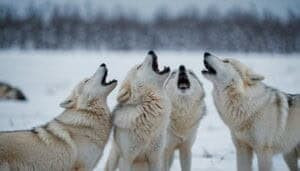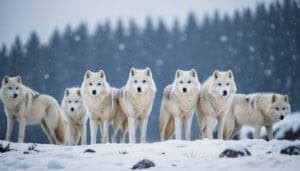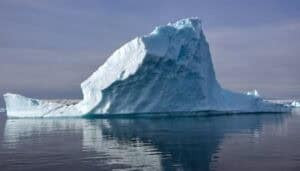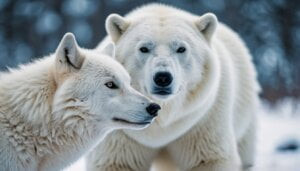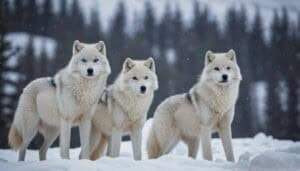Introduction
Arctic wolves exhibit unique reproductive behaviors that set them apart from other wolf species. This article explores the intricacies of their courtship, mating rituals, and the environmental factors that influence their breeding season
Additionally, we delve into the specific denning habits and challenges of rearing pups in harsh Arctic conditions, examining how pack dynamics and hierarchical structures affect reproductive success. Finally, we discuss the impacts of climate change and other environmental threats on the reproductive behaviors of Arctic wolves
Unique Reproductive Behaviors of Arctic Wolves
Arctic wolves, also known as Canis lupus arctos, exhibit several distinctive reproductive behaviors that differ significantly from those of other wolf species. These differences are primarily influenced by the harsh and isolated environments they inhabit
Understanding these unique behaviors offers insight into how Arctic wolves have adapted to thrive in some of the most extreme conditions on Earth
Courtship and Pair Bonding
Arctic wolves engage in complex courtship rituals that help establish strong pair bonds between mates
Courtship behaviors include playful interactions, scent marking, and vocalizations such as howling. These behaviors serve to strengthen the bond between the alpha male and female, who are typically the only breeding pair within a pack
Studies have shown that Arctic wolves are monogamous, with alpha pairs often remaining together for life. This long-term pair bonding is crucial for the survival of their offspring, as it ensures stable leadership and coordinated parental care
Research conducted in the 1990s by Mech and Packard found that stable alpha pairs lead to higher pup survival rates due to better resource allocation and protection from threats
Breeding Season Timing
The breeding season for Arctic wolves is relatively short and tightly synchronized. Mating typically occurs between January and March, with a gestation period of about 63 days. This timing ensures that pups are born during the spring, a period when environmental conditions are less severe and prey availability begins to increase
Compared to other wolf species, which may have a more extended breeding season, the Arctic wolf’s reproductive timing is a critical adaptation. It aligns the birth of pups with a narrow window of opportunity when conditions are optimal for their survival
For instance, gray wolves (Canis lupus) in temperate regions may have a breeding season that spans from January to April, reflecting the broader range of environmental conditions they encounter
Environmental Influences on Mating
The extreme environment of the Arctic plays a significant role in shaping the reproductive behaviors of Arctic wolves. The scarcity of food resources and the harsh climate require efficient and effective mating strategies. Only the alpha pair mates, which minimizes competition for limited resources and maximizes the care and attention each pup receives
The isolation of Arctic wolf populations also reduces the likelihood of inbreeding, as packs are spread out over vast territories
This geographical separation helps maintain genetic diversity within the species. A study published in 2004 by Carmichael et al. in “Molecular Ecology” highlighted the genetic differentiation among Arctic wolf populations, underscoring the influence of their remote habitats on reproductive isolation and diversity
Arctic wolves’ reproductive behaviors are a testament to their adaptability and resilience. Their courtship rituals, synchronized breeding season, and environmentally influenced mating strategies have evolved to ensure the survival of their species in one of the most challenging environments on Earth. By understanding these unique behaviors, we gain a deeper appreciation for the intricate balance of nature that allows Arctic wolves to thrive
Denning, Pup Rearing, and Survival
The denning and pup-rearing behaviors of Arctic wolves are crucial adaptations that help ensure the survival of their offspring in the extreme Arctic environment
These behaviors involve careful selection and preparation of den sites, meticulous care during the early stages of pup development, and strategies to overcome the numerous challenges to pup survival
Den Site Selection and Preparation
Arctic wolves invest significant effort in selecting and preparing den sites that offer maximum protection from predators and harsh weather conditions
Dens are typically located in areas with some natural cover, such as rocky outcrops or in the lee of a hill, to shield them from the elements. The dens are often dug into the ground or snow, providing insulation against the cold
The process of choosing a den site is highly strategic. A study by Cluff and Murray in 1995 noted that Arctic wolves prefer den sites with easy access to hunting grounds but far enough from human activity and other potential threats. The alpha female usually takes the lead in selecting and preparing the den, sometimes using the same site for several years if it has proven to be successful
Pup Birth and Early Development
The birth of Arctic wolf pups occurs in late May to early June. A typical litter consists of 4 to 6 pups, although the number can vary. At birth, the pups are blind and deaf, entirely dependent on their mother and the pack for warmth and nutrition
During the first few weeks of life, the pups remain inside the den, where the alpha female provides constant care. She nurses the pups and keeps them warm while the rest of the pack hunts and brings food back to the den. This period is critical, as the pups’ immune systems are still developing, making them vulnerable to diseases and environmental stresses
The weaning process begins at about five weeks of age, when the pups start eating regurgitated meat provided by the pack members. This transition is gradual, with the mother and other pack members playing a vital role in ensuring that the pups receive adequate nutrition
Survival Rates and Challenges
Pup survival rates in Arctic wolf populations can be highly variable, influenced by factors such as food availability, predation, and weather conditions. On average, around 50% of pups survive to their first year. This rate is comparable to other wolf species, although the specific challenges faced by Arctic wolves can differ significantly
Food scarcity is a major challenge. Arctic wolves primarily hunt large herbivores like muskoxen and Arctic hares, but these prey animals can be scarce, especially during the harsh winter months. The pack must work together efficiently to ensure enough food is available for the growing pups
Predation and human encroachment also pose significant threats. While adult Arctic wolves have few natural predators, pups are vulnerable to birds of prey, bears, and other carnivores. Additionally, as human activities expand into previously remote areas, encounters with humans and domestic animals can introduce new risks, such as diseases and direct conflict
Climate change is an emerging threat that exacerbates these challenges. Warming temperatures can lead to changes in prey distribution and availability, affecting the food supply for Arctic wolves. Additionally, melting permafrost and shifting weather patterns can disrupt traditional denning sites and impact the overall stability of the habitat
Despite these challenges, Arctic wolves demonstrate remarkable resilience and adaptability
The pack’s cooperative nature and the strong bonds between members play crucial roles in overcoming the harsh conditions of the Arctic. By working together, Arctic wolves enhance their chances of reproductive success and the survival of their pups in one of the world’s most unforgiving environments
Pack Dynamics and Hierarchical Influence
The social structure and dynamics within an Arctic wolf pack significantly influence their reproductive success. Understanding the roles of alpha pairs, the breeding hierarchy, and the cooperative rearing of pups provides insight into how these wolves maintain stable and thriving populations in their harsh environment
Role of Alpha Pairs
In Arctic wolf packs, the alpha pair, consisting of the dominant male and female, holds the primary breeding rights
These alpha wolves are typically the strongest and most experienced members of the pack. Their leadership is crucial for the survival and cohesiveness of the pack, as they make key decisions regarding hunting, territory defense, and pup rearing
The alpha female is primarily responsible for reproduction, while the alpha male provides protection and support. Their strong bond ensures a coordinated effort in raising pups, from selecting den sites to hunting for food. This partnership is vital in the Arctic, where resources are scarce, and conditions are extreme
Research by Mech (1999) indicates that the stability of the alpha pair directly affects the pack’s reproductive success. Stable alpha pairs tend to have higher pup survival rates due to their effective cooperation and resource management
Disruptions in leadership, such as the loss of an alpha, can lead to decreased reproductive success and even pack disbandment
Hierarchy and Breeding Rights
The hierarchical structure within an Arctic wolf pack is rigid, with clear roles and ranks that influence breeding rights
Typically, only the alpha pair breeds, a strategy known as “reproductive suppression.” Lower-ranking wolves, including beta wolves and subordinates, do not usually reproduce, which helps to reduce competition for resources and ensures that the alpha pair’s offspring receive the best possible care
This hierarchical structure is maintained through various social behaviors, including displays of dominance and submission. Wolves communicate their status within the pack through body language, vocalizations, and scent marking. These behaviors help to establish and reinforce the social order, ensuring that the alpha pair retains their breeding privileges
A study published in “Behavioral Ecology and Sociobiology” (2013) by Peterson and Ciucci observed that in some cases, subordinate wolves may attempt to mate if the alpha pair fails to produce offspring
However, such instances are rare and often lead to conflict within the pack, highlighting the importance of a clear and stable hierarchy for reproductive success
Cooperative Rearing of Pups
One of the most remarkable aspects of Arctic wolf social behavior is the cooperative rearing of pups. All pack members, regardless of their rank, participate in caring for the young. This includes hunting for food, protecting the den, and even regurgitating food for the pups
The cooperative nature of Arctic wolf packs enhances the survival rates of pups. By sharing responsibilities, the pack ensures that the alpha female can focus on nursing and nurturing the pups during their critical early weeks. Meanwhile, other members of the pack provide the necessary resources and protection
This cooperative behavior extends to teaching the pups essential survival skills. As the pups grow, they observe and learn from older pack members, gaining valuable experience in hunting, social interactions, and territory defense. This education is crucial for their development and eventual integration into the pack’s hierarchy
Research by Zimen (1981) emphasizes the importance of social learning in wolf packs, noting that pups raised in cooperative environments tend to be more successful in adapting to their roles within the pack. This collaborative approach not only benefits the pups but also strengthens the pack as a whole, enhancing its ability to thrive in the challenging Arctic environment
The pack dynamics and hierarchical structure of Arctic wolves play a pivotal role in their reproductive success
The leadership of the alpha pair, the clear breeding hierarchy, and the cooperative rearing of pups are all critical factors that contribute to the stability and resilience of Arctic wolf populations. These social structures and behaviors ensure that Arctic wolves can continue to thrive in their harsh and unforgiving habitat
Environmental and Climatic Impacts
Arctic wolves live in one of the most extreme environments on Earth, and their reproductive behaviors are significantly influenced by environmental and climatic conditions. Understanding how climate change, predation, and human encroachment affect these wolves is crucial for conservation efforts and predicting future trends in their population dynamics
Impact of Climate Change
Climate change poses a profound threat to Arctic wolves by altering their habitat and the availability of their prey
Rising temperatures and melting ice affect the distribution and abundance of key prey species, such as muskoxen and Arctic hares. These changes can lead to food scarcity, which in turn impacts the reproductive success and survival rates of Arctic wolf pups
A study published in “Global Change Biology” (2015) by Post and Forchhammer highlights how shifts in prey populations due to warming temperatures can disrupt the delicate balance of the Arctic ecosystem. For example, earlier snowmelt can cause a mismatch in the timing of prey availability, leaving wolf pups without adequate nutrition during critical growth periods
Additionally, climate change can directly impact the physical environment that Arctic wolves rely on for denning
Thawing permafrost and changes in snowfall patterns can destabilize traditional den sites, making them less suitable for raising pups. This can force wolves to relocate to less optimal areas, increasing the risk of pup mortality
Predation and Human Encroachment
Predation and human encroachment are significant threats to the reproductive success of Arctic wolves. While adult Arctic wolves have few natural predators, their pups are vulnerable to a range of threats, including bears, eagles, and other carnivores. Increased predation pressure can lead to higher pup mortality rates, reducing the overall reproductive success of the pack
Human activities, such as oil and gas exploration, mining, and increased Arctic shipping, pose additional risks
These activities can lead to habitat fragmentation, increased human-wildlife conflicts, and the introduction of diseases. A study in “Conservation Biology” (2012) by Johnson et al. found that human encroachment into Arctic regions often disrupts the natural behaviors of wildlife, including wolves, leading to stress and reduced reproductive success
Moreover, human-induced climate change exacerbates these threats by altering the natural landscape and making it more accessible to humans. As the Arctic becomes more navigable, the likelihood of human-wolf encounters increases, potentially leading to more frequent and severe conflicts
Adaptive Behaviors and Resilience
Despite the numerous challenges posed by environmental and climatic changes, Arctic wolves have demonstrated remarkable adaptability and resilience. These wolves have evolved several behaviors that help them cope with the harsh conditions of their environment and the pressures of climate change
One such adaptive behavior is their flexible diet. While Arctic wolves primarily hunt large herbivores, they are opportunistic feeders and will consume a variety of prey, including smaller mammals, birds, and even fish when available. This dietary flexibility helps them survive periods of food scarcity and ensures a more stable food supply for their pups
Arctic wolves also exhibit strong social cohesion and cooperative behaviors, which enhance their resilience. The pack structure allows them to share resources and responsibilities, increasing their chances of surviving and thriving in a changing environment
For example, during times of food shortage, pack members will prioritize feeding the pups, ensuring the next generation’s survival
Additionally, Arctic wolves have been observed altering their denning behaviors in response to changing environmental conditions. In areas where traditional den sites become unsuitable due to thawing permafrost or other factors, wolves have adapted by selecting alternative sites or modifying their denning strategies to protect their pups
A study by Musiani et al. (2007) in “Ecological Applications” highlights the importance of understanding these adaptive behaviors for conservation efforts
By recognizing and supporting the natural resilience of Arctic wolves, conservationists can develop strategies that help mitigate the impacts of climate change and human activities on these iconic predators
While environmental and climatic impacts pose significant challenges to Arctic wolves, their adaptive behaviors and resilience offer hope for their continued survival. Understanding the complex interactions between climate change, predation, human encroachment, and the wolves’ natural behaviors is essential for developing effective conservation strategies and ensuring the long-term stability of Arctic wolf populations
Conclusion
Arctic wolves exhibit unique reproductive behaviors that are intricately adapted to their harsh environment. From the courtship rituals and synchronized breeding season to the selection and preparation of den sites, every aspect of their reproduction is fine-tuned for survival in extreme conditions
The strong leadership of alpha pairs and the clear hierarchical structure within the pack ensure efficient resource allocation and protection of the young, while cooperative rearing practices further enhance pup survival rates
Environmental and climatic factors, such as climate change, predation, and human encroachment, present significant challenges to Arctic wolves. These influences affect prey availability, den site stability, and overall habitat conditions, impacting reproductive success
Despite these challenges, Arctic wolves demonstrate remarkable resilience through adaptive behaviors like dietary flexibility, social cohesion, and modifications to denning strategies
Understanding these unique reproductive behaviors and the environmental pressures Arctic wolves face is crucial for effective conservation efforts. By recognizing the adaptability and resilience of these wolves, conservation strategies can be developed to mitigate the impacts of climate change and human activities, ensuring the continued survival of Arctic wolf populations in their iconic, yet unforgiving, habitat



